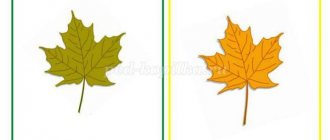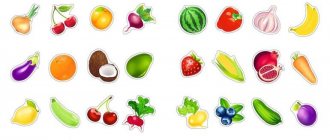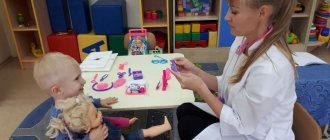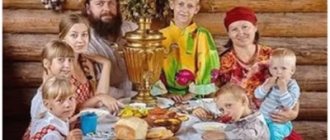Homework on the lexical topic: “Our region.” Our city" - senior speech therapy group
Our region. Our street.
Conversation: −
look at illustrations, photographs and postcards depicting our Land, what is it rich in?;
- ask the child the name of the city in which he lives, the street on which his house is located;
- Pay the child’s attention to what the city is named after, what it is famous for, tell us about the most important events that happened in our city, what attractions it has;
- “Select a sign and an action”
Region (which?) - polar, northern, native, rich,...
The city (which one?) is clean, bright, noisy, cheerful, snowy,...
Street (what?) – long, quiet, narrow, green,...
The townspeople (what are they doing?) - building, cleaning, repairing, having fun, decorating,...
- "Name it after example"
street - street
–
no streets
city –
town
–
no town
shop – shop
–
no shop
bridge –
bridge
–
no bridge
courtyard – courtyard
–
no yard
address –
address
–
no address
flashlight – flashlight – no flashlight
road
– path – no path
- "Count 2.5"
One green square two green squares five green squares
One tall building two tall buildings five tall buildings
One city pharmacy two city pharmacies five city pharmacies
One large area two large areas five large areas
One football field two football fields five football fields
- "Say it with the word 'urban'"
transport – city transport
apartment –
city apartment
houses – city houses
park -
city park
streets - city streets
theater –
city theater
post office – city post office
building -
city building
school - city school
station -
city station
residents - city residents
church -
city church
- Complete the sentences by changing the word WENT,
consolidating the skills of using prefixed verbs
Sasha to the house... (approached)
The boy across the road
...(crossed)
He entered the entrance ...(entered)
Over the bridge
...(crossed)
Sasha quickly left the entrance ...(went out)
Sasha to the park
...(reached)
From the house ...(moved away)
He went around the tree
...(walked around)
Our town
- Parents are recommended:
- remember with your child the name of the city in which he lives, the street on which his house is located, name the main street of the city;
- pay attention to what the city is named after, what it is famous for, tell about the most important events that happened in your city, what attractions it has;
— look at illustrations, postcards and photographs depicting your city;
- repeat with the child the home address, the address of the kindergarten;
¾ attitude towards your city and your street;
¾ why do you need to know your address?;
¾ Who can you tell your address and who can’t?
- remind you of the need to follow traffic rules.
- Didactic game “Name which one”
(formation of complex words):
house (what?) - multi-story, one-story, apartment.
3.
Didactic game “One - Many” (formation of the genitive plural of a noun)
:
one house - many houses, one street... (village, city...).
4.
Exercise in word formation using suffixes .
House - house, house, house.
City - town, town, settlement.
5.
Didactic game “Pick a sign”:
street (which one?) - quiet, noisy, narrow, wide, green
city (which?) - ..., house (which?) - .... apartment (what?)¾…
6.
Didactic game “Here and There”
Here is a house, and there are houses; here is a street, and there is ¾ ...; here is a store, and there is ¾...;
here is a pharmacy, and there is ¾ ...; here the area, and there ¾...; here is a flowerbed, and there is ¾...;
7.
Exercise in forming the plural of nouns
“Count 2, 5”
One square, 2..., 5...; One street, 2..., 5...; One house,… 2.., 5…
8.
Compose the story
“The House Where I Live” (child’s free story).
9.
We teach the child
to clearly pronounce words and phrases: traffic controller, sidewalk, policeman, traffic rules.
MAGAZINE Preschooler.RF
THEMED GAME “MY CITY”One of the most important and striking traits of preschoolers is curiosity. Children constantly ask questions and want answers right away. If adults cannot or do not want to explain to children what interests them, their curiosity disappears. Therefore, the only option for introducing children to the world around them is to learn how to answer any questions children may have.
In early preschool age, all the child’s activities are subordinated to one leading need - knowledge of the world around him and himself in it. The main means of satisfying this need still continues to be the sensory (sensual) development of reality through sensations, sensory perceptions, and visual representations. But at this age the thresholds of sensations begin to decrease. This is compensated by an increase in visual acuity and accuracy in distinguishing colors, development of hearing, and accuracy in estimating the weight of objects.
The most characteristic actions are those that allow the child to examine objects, highlight their most typical properties - to separate and combine sensations, giving them the characteristics of sensory standards, generally accepted patterns of perception. Such activity lays the foundation for the transition to a higher stage of development - from visual-effective to imaginative thinking. Rhythm and clarity become the most important conditions for the development of normal perception and comprehension of what is perceived.
It is very important during this period to teach children to name their hometown (village). Encourage them to talk about where they walked on weekends (in a park, square, children's playground, in the country). Pay attention to buildings and remember the streets along which children walk from home to kindergarten, what attractions there are in their hometown, what rivers or even seas are nearby.
To get acquainted with the city, to expand knowledge about the world around us, and to develop communication skills, I offer the game “My City” .
"MY CITY"
Goal: Expanding children's knowledge about the world around them, developing children's communication skills. Forming an idea of classification based on characteristics.
Age: 3-8 years
Number of players: group of children 10-12 people
Necessary equipment: “city” , with marked streets. Sets of geometric shapes (circle, square, triangle, rectangle), primary colors. A set of rectangles with the name of administrative buildings: school, kindergarten, pharmacy, post office, hospital, cafe, store, etc.
Game description: At the beginning of the game, the presenter reads a poem for finger gymnastics “My City” .
I love walking around the city! (They walk with their fingers on their knees) I like to watch, (Turns the head left and right)
I love counting! (clench - unclench their fists) Streets - once! (Bend fingers one at a time)
Area – two! Park - three! And four - I live in an apartment! Five - I'm walking in the park again!
Six - I’ll go to Belaya and look at the water! Seven – “Nalmes” , Palace of Culture, Beautiful and huge,
And it is located in the center! Eight - New Year's tree! Nine - I came across the Great War Monument...
Ten is our cinema! I will go around all of Maykop! (They walk with their fingers on their knees) I love the city very much!
(Clench and unclench their fists)
Children remember and name administrative buildings and stick them in random order on the playing field. Then they place the house figures according to the names of the streets. For example: on VESENNYA (the color with which spring is associated) there can be houses of various shapes, but only green. On the street "MORSKOY" - blue (light blue). And on the street of “MULTI-COLORED SQUARES” there are only squares, but of different colors, etc.
When the city is built, you can proceed to the next stage of the game. Each participant chooses a “house” where he “lives” and gives it a number (you can write it on a figure). A preliminary conversation is held “Where do I live?” . Children name their street and house or apartment number. Then the adult starts the game: “Katya needs to go to the store. What is the best way for her to get through? Children “pave” the way to the desired building, while naming which streets they need to go through and past which buildings. Every child should be a leader. That. children explore the city, learn to navigate the area, and expand their knowledge about aspects of public life.
Play is the most progressive method of teaching preschoolers. It is through play that a child’s abilities such as intelligence, resourcefulness, the ability to think logically, compare and remember are more easily formed. Play makes the learning process less tedious and much more effective.
| Next > |
Didactic games “My City”
Didactic games aimed at enriching the knowledge of preschool children about their hometown
"Buildings of my city"
Didactic task
. To develop children's powers of observation, the ability to find similarities and differences in the buildings depicted in the pictures, to activate children's vocabulary, to name the historical monuments of the city, to cultivate a love for their hometown.
Game rules
. Select only identical buildings in different pictures. The one who doesn't make a mistake wins. The paired pictures are looked for by the one the arrow points to.
Game actions.
Search for identical pictures. Arrow rotation.
Progress of the game.
Children sit at a table on which pictures are laid out. There are many of them (10 – 12), they are all different, but some of them are the same. As indicated by the arrow, the child names the buildings, their location, and purpose.
Didactic game “Collect a picture”
Didactic task.
Exercise children in composing a whole picture from individual parts, through the content of the pictures, consolidate children’s knowledge about their hometown, and cultivate love for their small Motherland.
Game rules.
Within a certain time, correctly assemble a whole picture from parts.
Game actions.
Search, folding parts of the picture.
Progress of the game.
The teacher, together with the children, looks at pictures depicting the sights of the city. Explaining the rules of the game, the teacher recalls the already known rule of how to put together a whole picture from individual parts. Having distributed the pictures according to the number of players, the teacher says: “Let’s start!” Children choose the right parts of their picture. Whoever put the picture together first gets a chip. Then you can exchange pictures and repeat the game. You must have 2 sets of pictures: one consists of whole pictures, the other of their parts (at least 9-12).
Didactic game "City Travel"
Didactic task.
To consolidate children's knowledge about their hometown, street names, and city attractions.
Game rules.
The sequence of moves is determined by the thrown dice, and the number of moves is counted with chips. The winner is the one who reaches the finish line first.
Game actions.
Throwing a die, moving a chip along the playing field.
Progress of the game.
Before starting the game, the teacher and the children look at photographs depicting the sights of the city. A short conversation is held about the names of streets and buildings in the city.
The rules of the game are then explained; You can move around the playing field only with the help of a chip, each time counting as many circles as will be indicated on the die, taking into account that a red circle means skip a move, green means move back, blue means forward.
The winner will be the one who makes no mistakes, counts the chips correctly and gets to the indicated place first.
Didactic game “My City”
Game task.
Strengthen your knowledge of the city's attractions. Identify historical monuments, their location, and give their description.
Game rules and game actions
depend on the game version. The route layout on the map may vary.
Didactic material.
A playing field on which the location of the most interesting memorable places is marked, cards of the same size with images of monuments, etc. The content of the cards depends on the version of the game: 1 – image and name of attractions; 2 - description of memorable places; 3 - numbers indicating the location of the monument on the diagram.
Progress of the game.
4-5 children can take part in the game. A map of the city is laid out on the table, and children receive cards depicting memorable places. The teacher offers to go on a city tour and mixes cards with descriptions, placing them face down. The game may gradually become more difficult.
Option 1.
The presenter takes out cards, naming the monument and the number indicating its location on the map. The guys who have a card with an image of the named attraction cover the corresponding place on the diagram with it.
Option 2.
The presenter takes out cards with a description, reads the text, without naming the monument and the number that indicates its location. Children must guess what exactly the teacher is talking about, name a monument or historical place, find it on the map and lay out the correct card.
Option 3.
The presenter takes out cards with numbers. Children who have a card with a picture of the corresponding number of the monument pronounce the desired name and talk about it. The game ends when all the places marked on the diagram are covered with cards. The participant who lays out his cards first wins.





